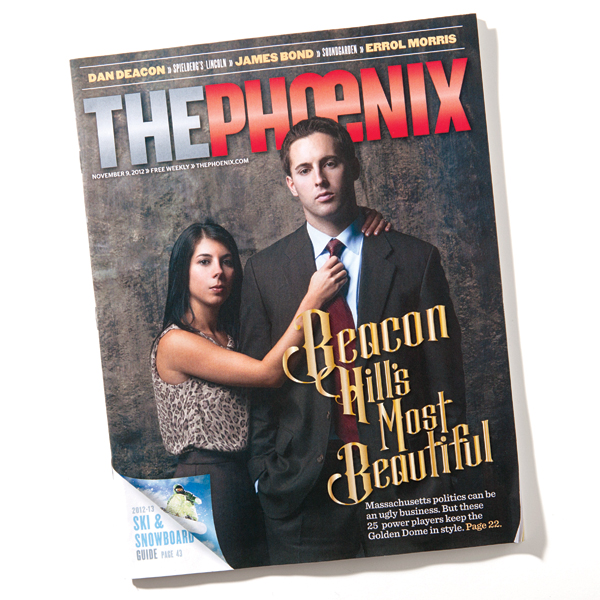What Happened to the Boston Phoenix?

The November 9, 2012, issue of the new Phoenix. / Photo by Samantha Carey
The Phoenix also developed a reputation as a writer’s paper. “It was unique in its function for writers,” says Mark Jurkowitz, who was the Phoenix’s media critic from 1987 through 1994, and again from 2005 to 2006. “It was clearly a place you wanted to go if you were thinking about long-form journalism.” This was especially true for young critics, who had seen a succession of top talent make extended stops at the paper before moving to major national publications. Janet Maslin, the paper’s music and film critic in the early 1970s, left for the New York Times and was succeeded by David Denby. Denby, for his part, ended up at the New Yorker, and was succeeded by Stephen Schiff. And Schiff went to Vanity Fair, but only after training David Edelstein, now the film critic for New York. “It was thrilling to be part of that,” Lloyd Schwartz says.
The Phoenix of the 1970s and 1980s is often remembered as a political paper, and it was indeed strong on state politics, with Sidney Blumenthal, Jon Keller, and Charlie Pierce all contributing. But it had a national reputation, too, built on cultural criticism. “Alternative papers insisted that culture was as important as politics,” Kit Rachlis, the paper’s former music editor, says. “In those days, in newspapers, to be a culture writer was to be on the bottom of the hierarchy.” The Phoenix helped change that. But the moment didn’t last.
Until the advent of the Internet, the Phoenix, like so many other papers, made its money on classifieds. It was a source of culture and news, but it was also the place where young people looked when they needed a place to live, or a date, or someone to play in their band. In 1989, Mindich expanded the idea and formed a company called Tele-Publishing Inc., which allowed people to respond to personal ads through voice mail. He licensed the TPI system to alt weeklies across the country and abroad, and eventually the enterprise employed more than 200 people. For a period in the late 1990s, TPI provided one of the largest shares of the company’s revenue, along with the classifieds.
The Internet broke both businesses, almost at the same time. “What has really killed the alt weeklies is that they were so dependent on classified ads,” says Dan Kennedy, an assistant professor of journalism at Northeastern who was a media critic at the Phoenix for 11 years. The dating site Match.com alone decimated TPI, which laid off scores of workers before shutting down this past spring.
And advertising wasn’t the only part of the alt-weekly proposition that suffered in the new digital age. “Around 2003, 2004, you could feel all that alternative energy dissipate onto the Web,” Kit Rachlis says. “What was really alternative? It was blogging: the earliest generation of bloggers. And then the economic model for newspapers was just blowing up.”
So was the economic model for radio, which meant trouble for Mindich’s WFNX. The station had never made much money, but it played a key role in discovering new music and helped Mindich make good on his commitment to free expression. In 1997, for example, the station broadcast a live reading of Allen Ginsberg’s Howl, in violation of federal obscenity laws.
Mindich founded WFNX in 1982, but it wasn’t until the explosion of grunge in the early 1990s that the station gained widespread acclaim. Famously, in 1994, a WFNX-sponsored concert at the Hatch Shell featuring Green Day turned into a riot, and in the months that followed, the station achieved some of its highest ratings ever. (According to Brad Mindich, Stephen Mindich’s son, his father had trouble deciding whether to make WFNX a rock or a country station when it launched. Brad, a teenager at the time, insisted that it needed to be rock.)